Welcome to my guide on growing vegetables properly! In order to have a successful vegetable garden, it’s crucial to understand and apply proper techniques, including organic practices. By mastering the basics of vegetable gardening, you can ensure the health and productivity of your plants. Whether you’re a seasoned gardener or just starting out, this article will provide you with the knowledge and tips you need to grow vegetables properly.
Key Takeaways:
- Choose a good location with adequate sunlight and well-drained soil.
- Select easy-to-grow vegetables that you and your family enjoy eating.
- Create a garden layout and plan ahead for success.
- Understand the appropriate planting timings for different vegetables.
- Use high-quality seeds or transplants.
Selecting the Right Location and Preparing the Soil
One of the first steps in growing vegetables properly is selecting the right location for your garden and ensuring the soil is well-prepared. The success of your vegetable garden depends on finding a spot that receives at least six hours of direct sunlight each day. Vegetables thrive in sunlight, so choose an area away from tall structures or trees that may cast shade. It’s also important to consider the accessibility of water and ensure the location has good drainage.
Once you’ve found the perfect spot, it’s time to prepare the soil. Start by removing any weeds, rocks, or debris from the area. Loosen the soil using a garden fork or tiller, making sure it is well-aerated. This will improve water drainage and allow the roots to penetrate easily. If your soil is heavy clay or sandy, it may benefit from the addition of organic matter, such as compost or well-rotted manure. These amendments help improve soil structure, retain moisture, and provide essential nutrients for plant growth.
Another essential aspect of vegetable gardening is practicing crop rotation. This means avoiding planting the same vegetables in the same spot year after year. Crop rotation helps prevent the build-up of pests and diseases in the soil, ensuring healthier plants. Plan your garden layout accordingly, grouping plants with similar nutrient requirements and growth habits. This will make it easier to manage and care for your vegetable garden.
Remember, the success of your vegetable garden starts with selecting the right location and preparing the soil. By providing your plants with optimal growing conditions, you’ll be on your way to enjoying a bountiful harvest. Stay tuned for section 3, where we’ll discuss choosing the right vegetables and planning your garden layout.
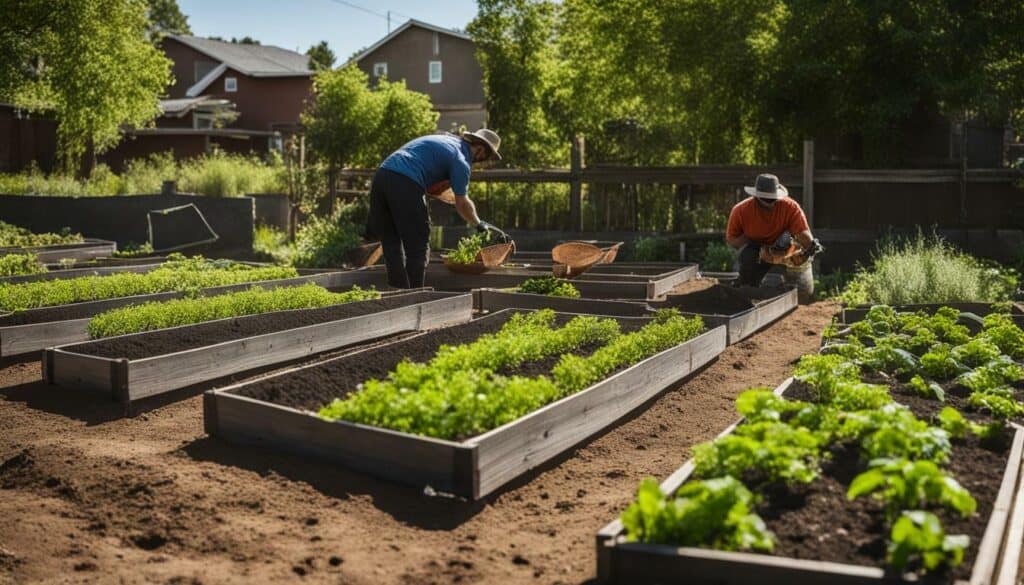
| Benefits of Selecting the Right Location and Preparing the Soil: |
|---|
| • Maximizes sunlight exposure for healthy plant growth |
| • Improves water drainage and prevents waterlogged soil |
| • Enhances nutrient availability for optimal plant nutrition |
| • Reduces the risk of pests and diseases |
Choosing the Right Vegetables and Planning Your Garden Layout
Choosing the right vegetables and planning your garden layout are key factors in ensuring a successful vegetable gardening journey. When selecting vegetables, consider the climate and growing conditions in your area. Some vegetables thrive in full sun, while others prefer partial shade. It’s important to choose vegetables that will thrive in your specific garden environment.
One useful option for growing vegetables is in containers. This allows you to have a vegetable garden even if you have limited space. Containers can be placed on a patio, balcony, or even indoors near a sunny window. They also provide flexibility, as you can move them around to optimize sunlight exposure. When choosing containers, make sure they have adequate drainage holes to prevent waterlogging.
Planning your garden layout is another crucial step. Consider the size and growth habits of each vegetable, as well as their compatibility with other plants. Some vegetables, like tomatoes and peppers, require staking or trellising for support. Others, such as leafy greens or root vegetables, can be planted closer together. Be mindful of spacing requirements to ensure proper air circulation and minimize the risk of disease.
| Vegetable | Spacing | Support Needed |
|---|---|---|
| Tomatoes | 2-3 feet apart | Stakes or cages |
| Lettuce | 6-12 inches apart | Not required |
| Cucumbers | 2-3 feet apart | Trellis or fence |
By carefully choosing your vegetables and planning your garden layout, you can maximize your harvest and create a visually appealing garden. Experiment with different combinations of vegetables to create a diverse and productive garden. Remember to rotate your crops each season to prevent the buildup of pests and diseases in the soil.
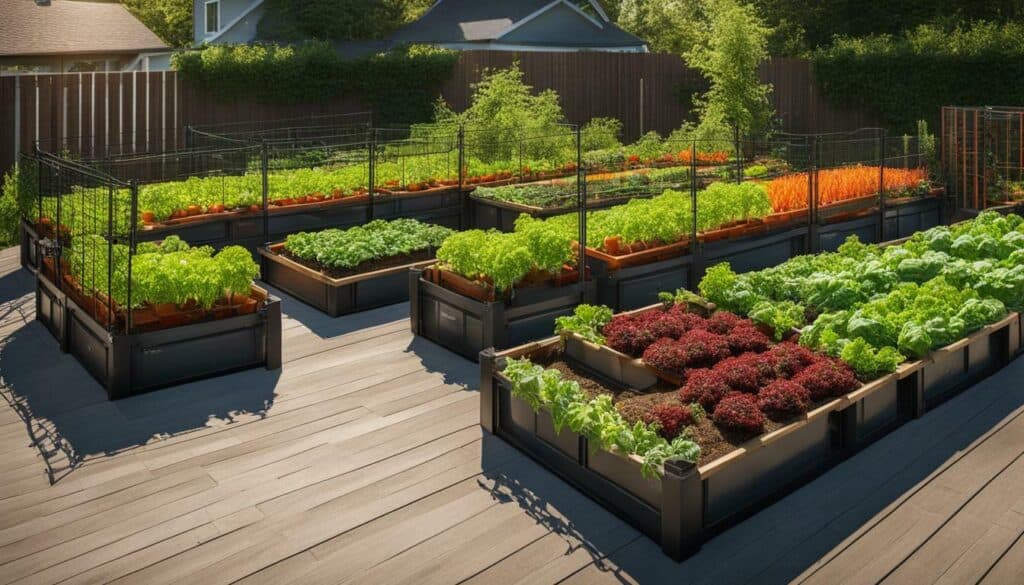
Tips for Successful Vegetable Gardening
- Start with a small garden or container if you’re a beginner, and gradually expand as you gain experience.
- Choose vegetables that you and your family enjoy eating, as this will motivate you to take better care of your plants.
- Provide proper care to your vegetables by watering them regularly, using organic fertilizers, and protecting them from pests and diseases.
- Stay organized by keeping track of planting dates, harvest times, and any special care instructions for each vegetable.
- Stay patient and observant, as gardening requires time and attention. Enjoy the process and learn from any challenges you encounter.
Remember, gardening is a rewarding and fulfilling activity. With the right planning and care, you can enjoy a bountiful harvest of homegrown vegetables that are both delicious and nutritious.
Understanding Planting Timings and Using Quality Seeds
Timing is crucial when it comes to planting vegetables, and using high-quality seeds can significantly impact your garden’s success. To ensure successful growth, it is important to understand the appropriate planting timings for different vegetables based on your climate and growing zone. Consult a vegetable planting guide, like the one below, to help you make informed decisions.
| Vegetable | Planting Time | Notes |
|---|---|---|
| Tomatoes | After the last frost date | Start seeds indoors 6-8 weeks before transplanting |
| Carrots | Spring or fall | Direct sow seeds in well-drained soil |
| Lettuce | Cool spring or fall | Succession plant for a continuous harvest |
A vegetable planting guide can also provide recommendations for seed varieties that are known to perform well in your region. Opting for high-quality seeds ensures that you are starting with the best possible genetic material, giving your vegetables the best chance to thrive. Look for seeds that are labeled as organic, non-GMO, and disease-resistant. These seeds are typically of superior quality and have been carefully selected for optimal performance.
Remember, proper seed storage is key to maintaining seed viability. Store your seeds in a cool, dark, and dry place to maximize their shelf life. Avoid exposing them to extreme temperatures or humidity, as this can reduce their germination rate.
Seed Starting Tips:
- Follow the instructions on the seed packet regarding planting depth and spacing.
- Keep the soil consistently moist, but not waterlogged, during the germination process.
- Provide sufficient light for seedlings by placing them near a sunny window or using grow lights.
- Gradually acclimate seedlings to outdoor conditions before transplanting them into the garden.
By understanding planting timings and using quality seeds, you can set your vegetable garden up for success. With the right information and a little TLC, you’ll be on your way to enjoying a bountiful harvest of homegrown vegetables.

Essential Soil Preparation Techniques
Proper soil preparation is vital for providing the necessary nutrients to your vegetable plants, ultimately improving their yields. By taking the time to prepare your soil correctly, you can ensure that your plants have the best possible chance of thriving. Here are some essential soil preparation techniques to consider:
- Test your soil: Start by getting your soil tested to determine its pH level and nutrient content. This will help you understand what amendments may be needed to create the ideal growing conditions for your vegetables.
- Add organic matter: Incorporating organic matter, such as compost or well-rotted manure, into your soil is crucial for improving its structure and fertility. This will help the soil retain moisture, provide essential nutrients, and encourage beneficial microbial activity.
- Remove weeds and debris: Clearing the area of weeds, rocks, and debris is important before planting your vegetables. Weeds compete with your plants for nutrients and moisture, so removing them will give your vegetables a better chance to thrive.
- Consider fertilizers: Depending on the nutrient needs of your specific vegetables, you may need to supplement your soil with fertilizers. Choose organic options that are suited for vegetable gardening, and apply them according to the instructions to avoid over-fertilization.
Remember, different vegetables have different soil preferences, so it’s important to research the specific requirements of the vegetables you plan to grow. By investing time and effort into preparing your soil properly, you’ll create an optimal environment for your vegetable plants to grow and produce bountiful yields.

| Vegetable | Preferred Soil Type | pH Range |
|---|---|---|
| Tomatoes | Well-drained loamy soil | 6.0-7.0 |
| Carrots | Sandy soil with good drainage | 5.8-7.0 |
| Spinach | Rich, fertile soil | 6.0-7.5 |
| Peppers | Well-drained soil with organic matter | 6.0-7.0 |
Watering and Monitoring Soil Moisture Levels
Watering your vegetable garden correctly and monitoring soil moisture levels are crucial aspects of successful vegetable cultivation. Providing the right amount of water at the right time ensures that your plants receive the necessary hydration for healthy growth and productivity. In addition, monitoring soil moisture levels helps prevent over or under watering, which can lead to plant stress or disease development.
When it comes to watering your vegetable garden, the key is to maintain soil moisture levels that are appropriate for the specific needs of your plants. Different vegetables have different water requirements, so it’s important to understand the preferences of the vegetables you are growing. For example, leafy greens like lettuce and spinach prefer consistently moist soil, while root vegetables like carrots and radishes prefer slightly drier conditions.
To determine when and how much to water, you can use a simple soil moisture meter or perform a manual check by inserting your finger into the soil. If the top inch of soil feels dry, it’s time to water. Avoid overwatering by providing enough water to thoroughly moisten the root zone without causing waterlogged conditions. Saturate the soil, but allow it to dry out slightly between watering sessions.
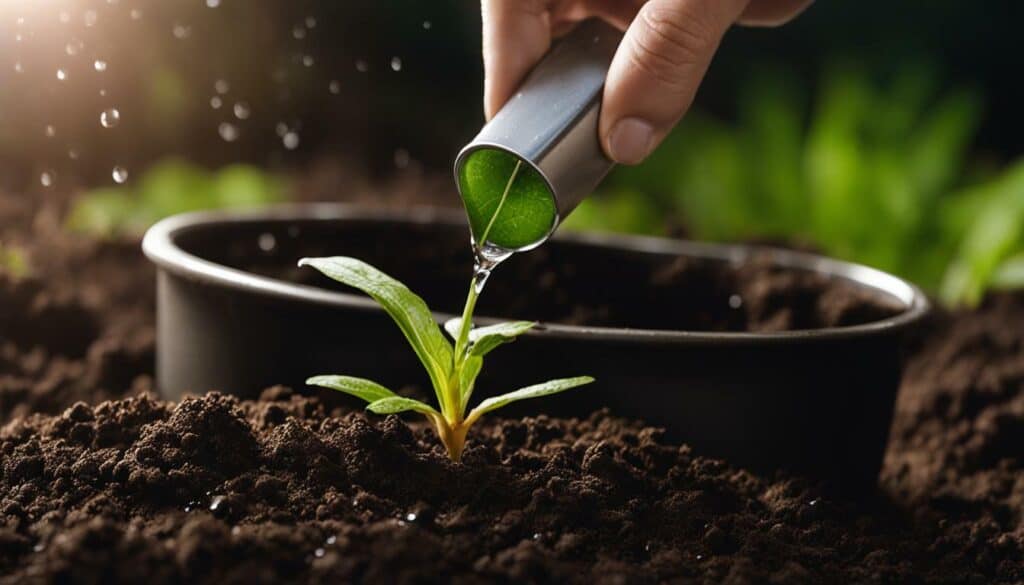
Another helpful practice is to mulch around your vegetable plants. Mulch acts as a protective layer that helps retain soil moisture, regulates soil temperature, and suppresses weeds. Apply a layer of organic mulch, such as straw or wood chips, around your plants, leaving a small space around the stem to prevent rotting. This will help conserve moisture in the soil and reduce the frequency of watering.
Remember, watering requirements may vary based on factors such as the weather, soil type, and the stage of plant growth. During hot and dry periods, you may need to water more frequently, while cooler and rainy periods may require less watering. Regularly monitoring soil moisture levels and adjusting your watering schedule accordingly will ensure that your vegetable plants thrive and produce a bountiful harvest.
Table: Recommended Watering Frequencies for Common Vegetables
| Vegetable | Watering Frequency |
|---|---|
| Tomatoes | Once or twice a week, allowing the soil to dry slightly between watering |
| Peppers | Once a week, maintaining slightly moist soil |
| Lettuce | Every 2-3 days, keeping the soil consistently moist |
| Carrots | Once a week, allowing the soil to dry slightly between watering |
| Zucchini | Twice a week, ensuring the soil remains evenly moist |
Pest and Disease Management for Healthy Vegetables
Keeping pests and diseases at bay is essential for maintaining healthy and thriving vegetables in your garden. The presence of pests can quickly destroy your hard work and lead to disappointing results. To prevent this, it’s important to practice effective pest management techniques and take proactive measures in maintaining the health of your plants.

Identifying Common Pests and Diseases
One of the first steps in managing pests and diseases in your vegetable garden is to identify the common culprits. Some pests that you may encounter include aphids, caterpillars, slugs, and snails. These pests can cause damage by feeding on your plants or transmitting diseases. Similarly, common diseases in vegetable gardens include powdery mildew, tomato blight, and fungal infections.
To identify and diagnose pests and diseases, regularly inspect your plants for any signs of damage, discoloration, or growth abnormalities. Conducting regular checks allows you to catch any issues early on and implement appropriate control measures.
Implementing Effective Control Measures
Once you have identified pests or diseases in your garden, it’s time to take action. There are various control measures you can employ, depending on the specific problem you’re facing.
Biological controls: Introducing natural predators or beneficial insects, such as ladybugs or praying mantises, can help control pests organically. These creatures feed on the pests, keeping their populations in check.
Organic sprays and treatments: Environmentally friendly insecticidal soaps, neem oil, or garlic sprays can be used to deter and control pests. These treatments are less harmful to the environment and pose minimal risks to beneficial insects.
Cultural practices: Implementing cultural practices, such as crop rotation, companion planting, and proper sanitation, can help prevent the spread of pests and diseases. Removing affected plant material and practicing good garden hygiene can reduce the chances of reinfestation.
| Pest/Disease | Control Measures |
|---|---|
| Aphids | Introduce ladybugs or use insecticidal soap |
| Caterpillars | Handpick or use organic BT (Bacillus thuringiensis) |
| Slugs and Snails | Use beer traps or diatomaceous earth |
| Powdery Mildew | Ensure proper air circulation and apply sulfur-based fungicides |
| Tomato Blight | Remove affected plant parts and practice crop rotation |
| Fungal Infections | Apply copper-based fungicides and maintain proper plant spacing |
By implementing these pest and disease management practices, you can enjoy a healthy and bountiful vegetable garden. Regular monitoring, early intervention, and the use of organic and sustainable methods will help you achieve successful results.
Harvesting and Enjoying the Fruits of Your Labor
After all your hard work, it’s time to reap the rewards by harvesting and savoring the delicious flavors of your homegrown vegetables. There’s something truly satisfying about picking fresh vegetables from your own garden and using them in your favorite recipes. Not only are you enjoying the fruits of your labor, but you’re also benefiting from the nutritional value and superior taste of homegrown produce.
When it comes to harvesting your vegetables, timing is key. Each vegetable has its own optimal harvest time, and it’s important to be patient and wait for them to reach their peak ripeness. Harvesting too early can result in underdeveloped flavors, while harvesting too late can lead to overripe or tough vegetables. Consult a vegetable planting guide to determine the ideal harvesting time for each of your crops.
As you gather your vegetables, handle them with care to prevent damage. Use a sharp knife or pair of garden shears to cut the vegetables from the plant, taking care not to bruise or injure the surrounding foliage. Place them gently in a basket or harvest container, being mindful of delicate varieties like tomatoes and peppers.
| Vegetable | Optimal Harvest Time |
|---|---|
| Tomatoes | When fully colored and slightly firm |
| Carrots | When roots are mature and crisp |
| Lettuce | When leaves are full-sized but still tender |
| Green Beans | When pods are firm and snap easily |
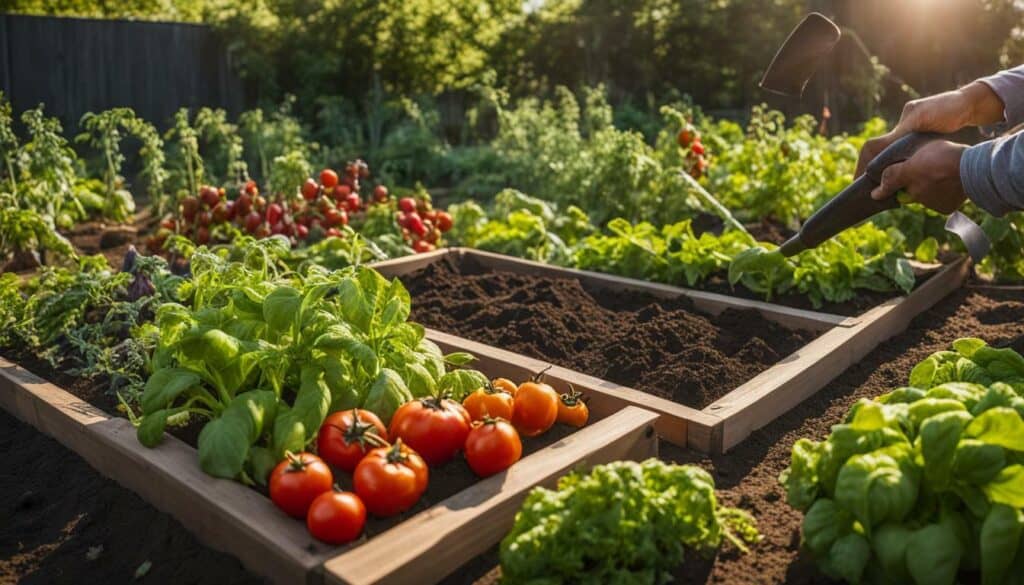
Once you’ve harvested your vegetables, it’s time to enjoy them in a variety of delicious dishes. Whether you’re making a fresh salad, stir-fry, or hearty vegetable soup, the flavors of your homegrown vegetables will elevate any recipe. Don’t be afraid to experiment and try new cooking techniques to showcase the natural flavors and textures of your harvest.
Remember, vegetable gardening is a continuous learning process. Each season presents new opportunities to refine your techniques and expand your knowledge. Enjoy the journey of growing your own food and relish the satisfaction of providing nourishing meals for yourself and your loved ones.
Conclusion
By mastering the basics of vegetable gardening, such as selecting the right location, preparing the soil, and choosing the right vegetables, you can embark on a successful gardening journey right in your own backyard. Understanding the importance of these fundamental aspects will set you on the path to grow vegetables properly and enjoy a bountiful harvest.
When it comes to selecting a location for your vegetable garden, consider factors like sunlight and soil drainage. Most vegetables require at least six hours of direct sunlight each day, so choose a spot that receives adequate sunlight. Additionally, ensure that the soil is well-drained to avoid water stagnation, which can lead to root rot and other plant diseases.
Starting with a small garden and choosing easy-to-grow vegetables that you and your family enjoy eating is a practical approach. Consider the space you have available and your level of experience. Planning ahead and creating a garden layout will help optimize the use of space and ensure that each vegetable has the proper room to grow.
Timing is crucial in vegetable gardening. Understanding when to plant different vegetables based on your climate will maximize their chances of success. Refer to a vegetable planting guide to determine the best planting times for each crop. Additionally, using high-quality seeds or transplants will give your vegetables a head start and improve their overall health and productivity.
Proper soil preparation is vital for providing essential nutrients to the plants. Add organic matter, such as compost or well-rotted manure, to improve soil structure and fertility. Consider conducting a soil test to determine any deficiencies and amend accordingly with the appropriate organic fertilizers. Remember, healthy soil leads to healthy plants and higher yields.
Finally, don’t forget to water your vegetable plants regularly and monitor soil moisture levels. Each vegetable has different water requirements, so it’s essential to provide adequate hydration without overwatering. Mulching around the plants can help retain moisture and reduce weed growth. Keep a close eye on the soil moisture levels to ensure your plants are thriving and avoid issues like drought stress or waterlogging.
By following these essential practices and mastering the basics of vegetable gardening, you can create a thriving garden that yields delicious and nutritious homegrown vegetables. Enjoy the rewards of your hard work, and savor the flavors of your own bountiful harvest!
What Are Some Basic Plants That Beginners Should Start With in Their Vegetable Garden?
If you’re a beginner looking to start a vegetable garden, a basic beginner plants guide can help you get started. Some easy-to-grow options include tomatoes, lettuce, cucumbers, and herbs like basil and mint. These plants are low-maintenance and yield tasty results, making them perfect for beginners. Get your hands dirty and embrace the joys of gardening with these simple choices.
FAQ
Q: What are the basics of vegetable gardening?
A: The basics of vegetable gardening include selecting a good location, ensuring proper sunlight and well-drained soil, starting with a small garden, choosing easy-to-grow vegetables, planning the garden layout, and understanding when to plant different vegetables based on the climate.
Q: How do I select the right location and prepare the soil?
A: To select the right location for your vegetable garden, choose an area that receives adequate sunlight and has well-drained soil. To prepare the soil, add organic matter and fertilizers to provide nutrients to the plants.
Q: Which vegetables should I choose and how do I plan my garden layout?
A: Choose vegetables that you and your family enjoy eating and that are easy to grow. Plan your garden layout by considering the space available and the growth habits of the vegetables. You can also grow vegetables in containers if space is limited.
Q: When should I plant different vegetables and how do I use quality seeds?
A: The planting timings for different vegetables depend on the climate. Consult a vegetable planting guide for specific information. It is important to use high-quality seeds or transplants to ensure healthy growth.
Q: What are essential soil preparation techniques for growing vegetables?
A: Essential soil preparation techniques include adding organic matter, such as compost, to improve soil quality and fertility. Proper soil preparation helps to provide the necessary nutrients for the plants and improve vegetable yields.
Q: How often should I water my vegetable plants and how do I monitor soil moisture levels?
A: Water your vegetable plants regularly, ensuring the soil is consistently moist but not waterlogged. Monitor soil moisture levels by checking the soil with your finger or using a moisture meter. Proper watering techniques are important for healthy plant growth.
Q: How do I manage pests and diseases in my vegetable garden?
A: Effective pest and disease management is crucial for maintaining healthy vegetable plants. Use organic pest control methods, such as companion planting and natural predators, and monitor your plants regularly for any signs of pests or diseases.
Q: How do I harvest and enjoy my homegrown vegetables?
A: Harvest your vegetables at the right time by checking for maturity indicators, such as size, color, and firmness. Enjoy the fruits of your labor by incorporating your homegrown vegetables into delicious meals and savoring the fresh flavors.
Q: What is the importance of mastering the basics in vegetable gardening?
A: Mastering the basics of vegetable gardening is essential for successful and rewarding results. By understanding the fundamentals of vegetable cultivation, you can create a thriving garden and enjoy the satisfaction of growing your own nutritious and delicious vegetables.

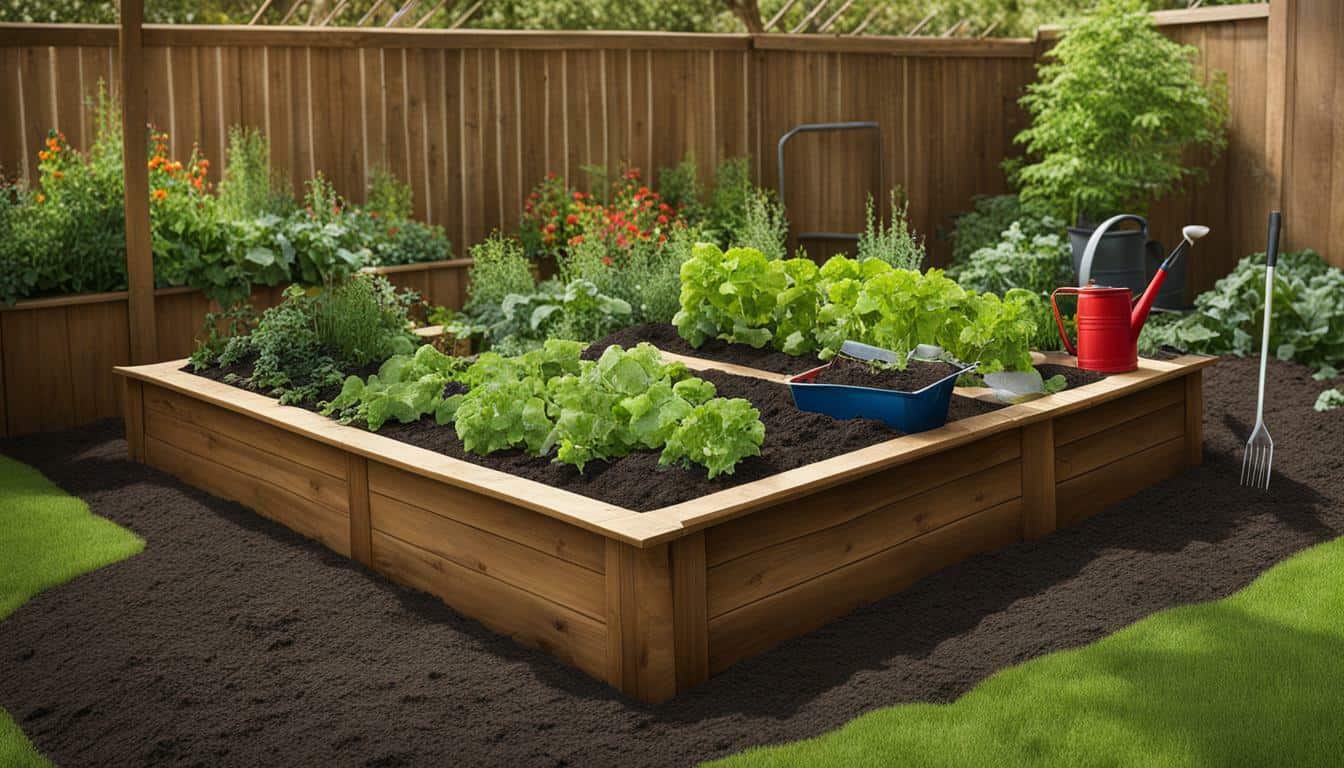



Leave a Reply